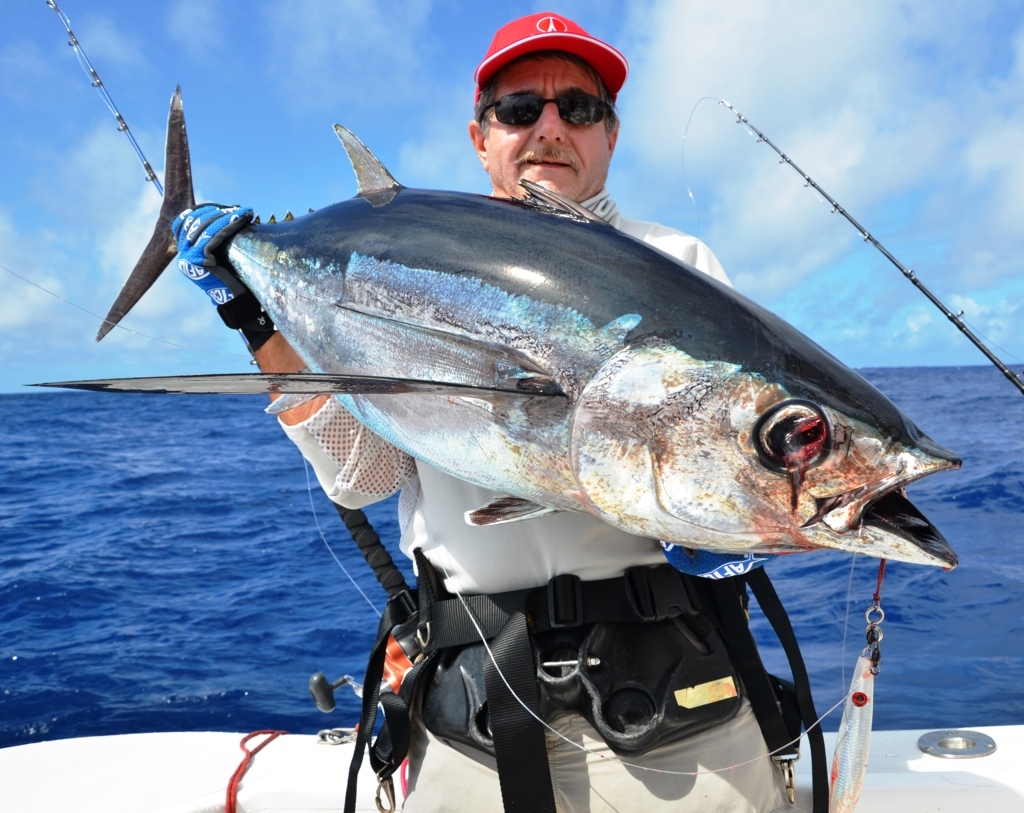Tuna is one of the world’s most popular fish, but there are different types, each with its flavor profile and specific cooking methods.
Meanwhile, this comprehensive guide to different types of Tuna will help you become an expert on this seafood so you can buy the right kind.
It will also help you prepare it correctly and serve it to your guests in a way that showcases its unique flavor.
Read on to learn about the most common types of Tuna, what each has to offer, and how you can use them in your dishes!
1. Longtail Tuna

Longtail tuna is one of the different types of Tuna, a pelagic fish found in the open waters of the Indian and Pacific Oceans.
It is an important commercial fish, and its flesh is used in a wide range of products, including canned tuna, sushi, and sashimi.
The longtail tuna has a long, streamlined body with a large head and a forked tail.
It is a fast swimmer and can reach up to 50 km/h (30 mph). The fish is blue-green or silver-grey, with dark vertical stripes on its sides.
2. Blackfin Tuna
Blackfin tuna is a small to medium-sized fish in tropical and subtropical waters worldwide. It is prized for its flavor and is often used in sushi.
Furthermore, the blackfin tuna has a dark blue back and silvery-white belly.
The tuna’s fins and tail are black. It can grow to about 3 feet long and weigh up to 60 pounds.
Also, they typically live between 20 and 40 years. They live in warm ocean waters near the surface, feeding on squid, herring, mackerel, anchovies, and sardines.
3. Pacific Bluefin Tuna
The Pacific bluefin tuna is the largest of all the different types of Tuna and can weigh up to 1200 pounds! They are also the fastest swimming fish in the sea, reaching up to 50 miles per hour.
In addition, these majestic creatures are found in the open waters of the Pacific Ocean. And migrate long distances each year.
Unfortunately, they are also among the most endangered fish in the world due to overfishing.
But there is still hope—by working together, we can protect this species for future generations to enjoy.
4. SkipJack Tuna
The Skipjack Tuna is the most common of the different types of Tuna. It’s found in cans of light Tuna and is often used for sushi.
The fish has a dark blue back, silver sides, and a white belly. Skipjack Tuna can grow up to four feet long but are usually around two feet when caught. They’re potent swimmers who prefer warmer waters.
5. Yellowfin Tuna
The yellowfin tuna is one of the larger species of Tuna, weighing up to 400 pounds.
They’re found in tropical and subtropical waters worldwide and are a popular target for commercial and recreational fishers.
Interestingly, the flesh of yellowfin tuna is pink to red, with a large amount of fat running through the center of the fish.
This makes yellowfin tuna an excellent sushi, sashimi, and steak choice.
6. Frigate Tuna
The frigate tuna is a species of tuna in the family Scombridae. It is a pelagic fish that prefers warm oceanic waters and is found in tropical and subtropical waters around the world.
In addition, it can grow to 2.5 m (8 ft 2 in) and weigh up to 130 kg (290 lb). Importantly, frigate tuna is one of the commercial fish among the different types of tuna.
And is prized for its pink or red meat. The fish are caught using purse seine nets and longlines.
7. Bigeye Tuna
This species is known for its distinctive large eyes. Bigeye tuna grows to be very large, up to eight feet long, and weighs 400 pounds.
Furthermore, the bigeye tuna is a prized fish by recreational and commercial fishers.
This species is found in tropical and temperate waters around the world. Sushi lovers know bigeye tuna as ahi.
8. Slender Tuna
The first of the different types of Tuna is slender Tuna. This type of Tuna is long and thin, with a small head. Moreover, they are found in the open ocean and feed on small fish.
Slender Tuna are fast swimmers, able to reach speeds of up to 50 miles per hour.
Their bodies grow to 10 feet long and weigh between 100 and 200 pounds.
9. Black Skipjack
The black skipjack tuna is a species of ray-finned fish in the family Strombidae. It is found in the western Atlantic Ocean, from Massachusetts to Florida in the United States.
The black skipjack tuna is found in the eastern Atlantic Ocean, from Senegal to Angola. It is also found in the Gulf of Mexico and the Caribbean Sea.
This fish can grow up to 80 cm (31 in) in length and weigh 18 kg (40 lb). It is one of the different types of Tuna, an essential commercial fish used for food, bait, and oil.
10. Mackerel Tuna
These are the minor and more typical of the different types of tuna. They have a dark blue back with silver sides and a white belly.
These types of Tuna are usually around 3 feet long and can weigh up to 60 pounds. The meat is pinkish-red and has a firm texture.
It’s perfect for sushi, sashimi, and searing. However, if you’re looking for a good steak, skip this one because it doesn’t cook well.
11. Albacore Tuna
This is the most common type of Tuna in the United States. It has a light pink flesh and is usually sold canned.
Albacore tuna is high in mercury, so limiting your consumption is essential.
In addition, fresh Albacore can be eaten occasionally but not regularly. Sardines are a good alternative because they have less mercury.
12. Little Tunny
The little tunny is the most common type of Tuna found in canned products. It’s also known as false Albacore and bonito.
In addition, Little tunnies are smaller than other types of Tuna, with an average length of two to three feet.
They’re dark blue on the back and sides, with a silver belly. They can be found in tropical and temperate waters worldwide.
Also, they’re relatively easy to catch, so they are one of the cheapest types of Tuna you’ll find at your local grocery store.
Little tunny is the most common type of tuna found in canned products. It is also known as false Albacore and Bonito.








